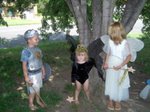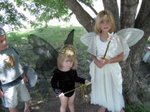Little Joe said...
I'll admit to bringing the New Year's Cookies to the ethnic meal. In case anyone is interested in knowing how I make them, here is the recipe:

New Year’s Cookies
(Raisin Fritters)
“Niejoasch Küake” or “Portselkje”
2 C. raisins (plumped)
½ C. sweet cream
¼ C. butter
2 eggs (beaten)
½ t. vanilla
1 C. potato water
1 T. sugar
2 T. active dry yeast
3 C. flour (plus about 1 C. extra flour, the amount will depend on the size of eggs and humidity on the day you are making these fritters)
¼ C. sugar
2 t. salt
1 t. baking powder
½ t. nutmeg
sugar for coating
Plump raisins by pouring boiling water over them and allow to soften for 10-15 minutes; drain. Scald cream; add butter and cool to lukewarm; add beaten eggs and vanilla. Dissolve 1 T. sugar in warm potato water and add yeast to activate. Sift 3 C. flour and the other dry ingredients together. Place cream mixture, yeast mixture and dry ingredients in a mixing bowl and stir to combine. Finish by kneading in the extra flour and raisins to make a soft dough. (If using a bread machine, place cream mixture, dry mixture and yeast mixture in bread pan and allow to mix on the dough cycle, adding additional flour until the dough pulls away from the sides of the pan. When the machine mixing has ended, carefully add raisins and mix thoroughly throughout the dough—otherwise the mixing paddle will beat the raisins to pieces. It works best to take the dough out of the pan and knead the raisins in by hand. One can also do this in the bread machine pan using a rubber spatula. Mixing a small amount of flour with the raisins will help keep them in the dough so they won’t fall out.) Allow to rise until double in bulk. Pinch off small balls of dough and place on baking sheet. When they have raised again fry in deep, hot fat until golden brown (about 2—3 minutes per side). Some recipes call for less flour, resulting in a batter rather than dough. After the batter has raised, it is dropped by spoonfuls into the hot fat with the result being a football-shaped pastry. Remove fritters from hot fat and cool. Before serving, place several fritters at a time in a sack with sugar and shake to coat evenly.
The cultural connection:
Dutch Mennonites moving to the Vistula River delta (in present day Poland) in the 16th century most likely brought with them a tradition of serving fried cakes or fritters on New Year’s Day. The Dutch version was called Oliebollen (oh-lee-bow-len) or Oliekoeks (literally oil balls or oil cakes) because they were fried in oil. Cakes and pastries fried in deep fat are still eaten in some northern European countries to celebrate the New Year. They are a symbol of affluence and luxury. Fried pastries carried with them the wish for a prosperous, fat (abundant) New Year.
The Low German speaking Mennonites carried the tradition to Russia in the late 18th and early 19th centuries. In Low German they are called Portselkje (port-zell-kya). When the spongy yeast batter or dough is dropped by spoonsful into hot, deep fat, the dough puffs up, tumbles over and fries to a golden brown. “Portsel” in Low German means tumbling over. Hence the name, “Portselkje”.
The ingredients of New Year’s Cookies are symbolic of a prosperous and happy New Year:
Flour & potato water = the necessities of life
Cream, butter and frying oil = abundance, luxury
Sugar = sweetness
Eggs = reproduction, prosperity
Yeast & baking powder = growthSalt = a preserving and savoring quality
Vanilla & nutmeg = a flavorful and spicy life
Raisins = fruitfulness
The recipe is from my Mama.
Cultural connection/history from “Mennonite Foods & Folkways from South Russia, volume 1” by Norma (Jost) Voth.












